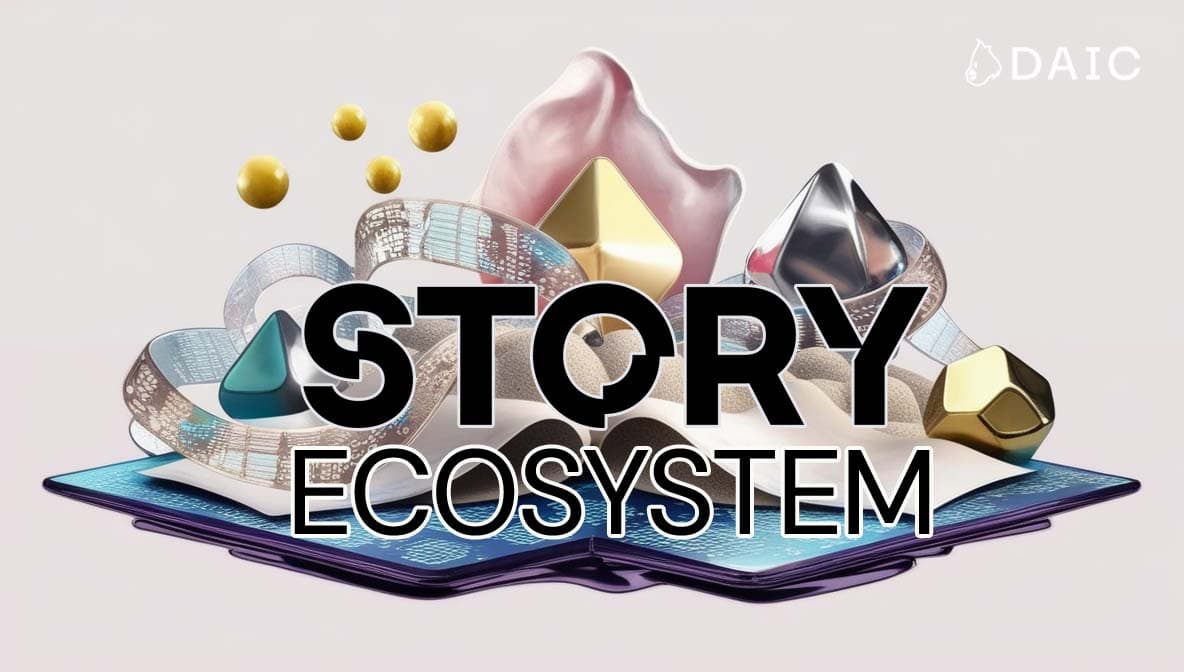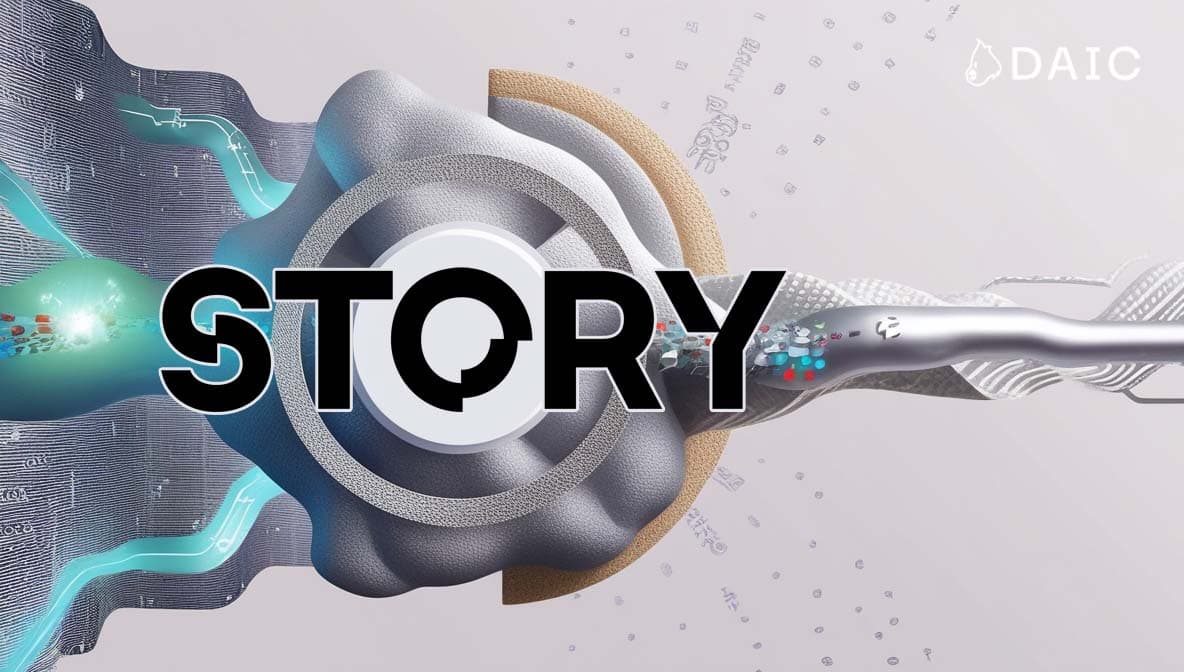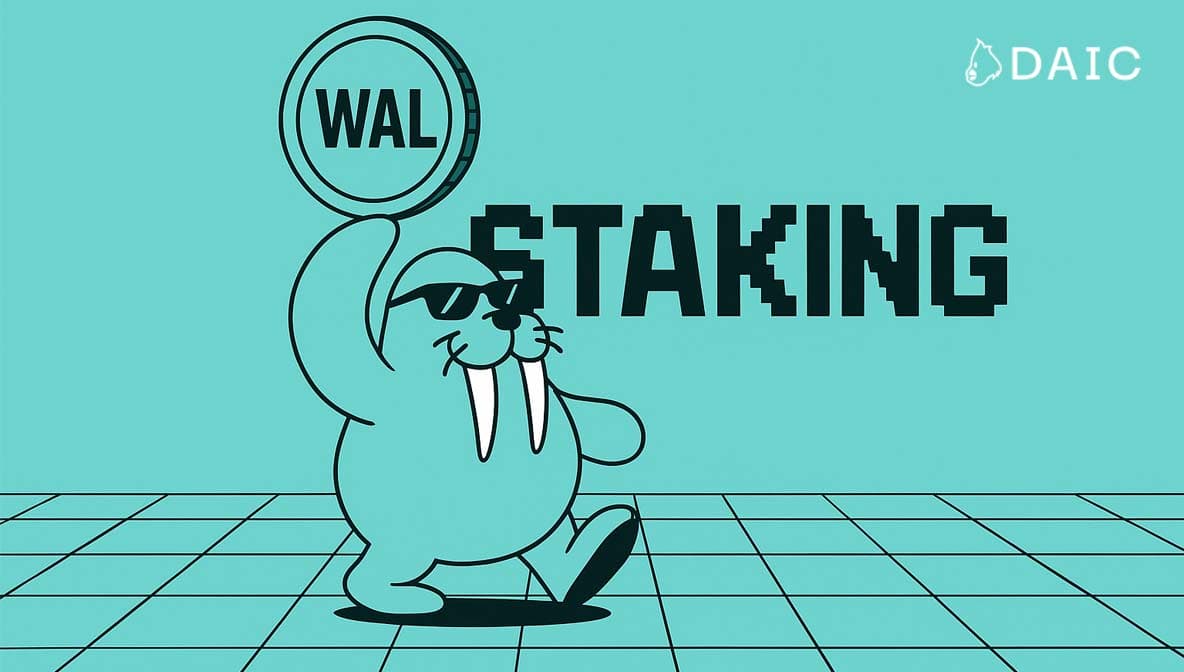The continued growth of Web3 technologies comes with tremendous opportunities as well as mass-scale infrastructure challenges, namely the efficient and stable management of large data. Storing substantial digital assets—such as rich media, extensive datasets, or application binaries—directly on many blockchains often remains economically impractical or technically constrained. Addressing this pressing demand, Walrus has emerged as a solution that provides a scalable and programmable foundation for Web3 data storing. This article delves into the Walrus protocol, outlining its key features, technology, and implication on the Web3 ecosystem.
Key Takeaways
- Programmable Data: Walrus allows interaction with the stored data via smart contracts for more dynamic dApp development.
- Efficient & Resilient: It utilizes advanced encoding techniques that reduce storage cost and robust data availability.
- Mysten Labs Expertise: Developed by the Sui team, bringing technical credibility and high Sui ecosystem compatibility.
- Live on Mainnet: Walrus launches from March 2025 and is available for real-world deployment.
- Versatile Web3 Storage: Designed for diverse data types (NFTs, AI, websites) with a long-term goal of cross-chain compatibility.
Defining Walrus: Beyond Basic Storage
Walrus represents a significant evolution in decentralized data storage. It functions as both a storage network and an application development platform, specifically engineered to efficiently and reliably manage large volumes of digital information online – everything from rich media files and AI datasets to the resources needed for decentralized websites and portals.
What truly sets Walrus apart is its storage programmability. Unlike traditional storage where data is passively stored, Walrus turns stored data into active on-chain objects, allowing developers to use smart contracts to build logic around the data itself directly, making it possible to build much more dynamic and complex decentralized applications than previously possible.
This new capability is made possible by a fault-tolerant and high-level architecture:
Decentralized Network: Walrus operates through a network of independent Storage Nodes that are responsible for physically holding the data. The system is designed to grow and adapt with a dynamic set of these participating nodes.
Intelligent Data Handling: For big data files uploaded, Walrus employs advanced data encoding algorithms (erasure coding). Instead of simply making a number of full copies (which would be inefficient), the data is encoded, broken up, and distributed smartly amongst the network nodes. This approach provides incredible resilience, with data being safe and fully recoverable even if some nodes fail (it's designed to be resilient against up to 1/3 Byzantine, or faulty/malicious, nodes). This approach also provides the foundation for the protocol's low cost.
Security and Coordination (DPoS & Sui): Integrity of the network and election of reliable Storage Nodes are ensured through a Delegated Proof-of-Stake (DPoS) system operated with the native WAL token. Token holders delegate their stake to node operators they believe in. Operators with sufficient support get elected into a dynamic 'Current Committee' that performs network operations and is rewarded. Most critically, the Sui blockchain is the coordination layer, which executes essential operations like processing payments, representing storage rights and data metadata as transferable Sui objects, enabling proofs of data availability, and coordinating node activity using smart contracts.
Supporting Infrastructure: The architecture also provides for roles of optional features like Aggregators, which essentially restore data for users who request to fetch, and Caching layers that can function in a similar way to Content Delivery Networks (CDNs) to further improve data access.
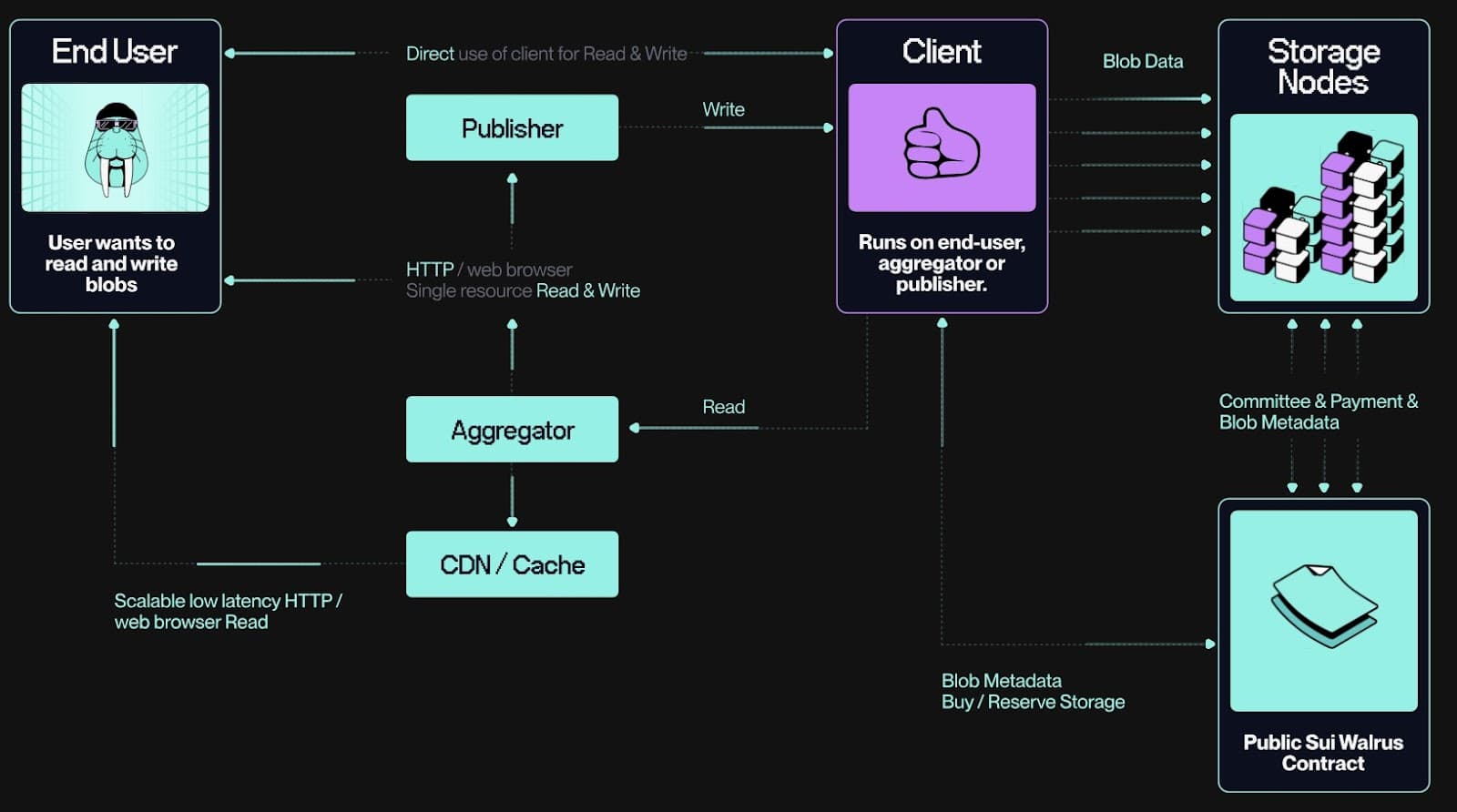
Essentially, Walrus performs the role of storage (encoding data, distributing and presenting it through nodes) while using Sui as the trusted backbone for coordination, security, programmability, and economic settlement.
The WAL Token Economy
The Walrus network is maintained by its native utility token, WAL, which facilitates different operations on the network.
Most importantly, users utilize WAL tokens to pay for data storage services offered on the network. Besides, WAL is essential in the security and decentralization of the network through its Delegated Proof-of-Stake (DPoS) process. Token holders contribute to network integrity by staking their WAL to support trusted validator nodes. In return for this support, both the delegators and the node operators themselves earn staking rewards, funded primarily by fees paid for storage and potentially topped up with protocol rewards. Beyond payments and staking, WAL tokens will also play a role in future governance of the Walrus protocol, enabling stakeholders to vote on important parameters and future upgrades.
The overall maximum supply of 5 billion WAL tokens is allocated among a variety of primary categories aimed at aiding sustainable growth in the network, security, and community participation.
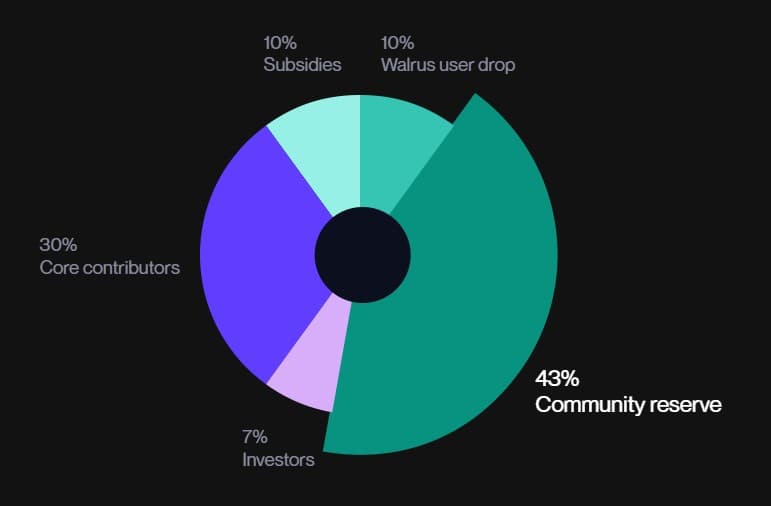
Community Reserve (43.00%): This largest allocation is dedicated to fostering the long-term health and expansion of the Walrus ecosystem. These funds are intended for community grants, developer support programs, core protocol research, user incentive programs, community events, hackathons, and other initiatives, managed by the Walrus Foundation. A portion (690 million WAL) was available at launch, with the remainder unlocking linearly until March 2033.
Walrus User Drop (10.00%): Reserved for direct drops to members of the community from the Sui and Walrus ecosystems who have been actively involved or will meaningfully interact with the protocol. This fully vested share includes the initial pre-mainnet airdrop (4%) and subsequent post-mainnet drops (6%).
Subsidies (10.00%): This reserve is held to supplement payments to storage node operators, particularly during the initial growth phase of the network, when the organic fee base accumulated through users takes time to develop. These tokens vest linearly over 50 months after the mainnet launch.
Core Contributors (30.00%): To thank the teams and individuals responsible for the core engineering, infrastructure build-out, security deployment, growth plans, and operations that brought Walrus into being. These are:
- Early Contributors (20%): Subject to a 4-year unlocking schedule with a 1-year cliff.
- Mysten Labs (10%): With 50 million WAL on launch, and the remainder linearly vest up to March 2030. Such vesting schedules are to ensure continued alignment with Walrus long-term success.
Investors (7.00%): This portion is kept for investors who financially supported the Walrus project. Such tokens are lock-up, with a release occurring 12 months after mainnet launch (roughly March 2026).
The Team Behind Walrus
Mysten Labs' development of Walrus provides the project unmatched technical credibility from significant technical experience. Created in September 2021 by five founding ex-Meta executives and leading researchers of the cutting-edge Novi/Diem blockchain venture (including CEO Evan Cheng and CTO Sam Blackshear), Mysten Labs was established with the vision to build foundation infrastructure for a fully decentralized web, extending ideas initiated in their time at Meta.
Mysten Labs possesses world-class expertise in distributed systems, cryptography, consensus mechanisms, and smart contract languages (particularly Move), demonstrated by their successful creation and launch of the popular Sui layer-1 blockchain prior to introducing Walrus. This deep technical foundation is evident in Walrus's design and its seamless integration with the Sui ecosystem. Further demonstrating a penchant for openness and community engagement, the base Walrus codebase is open-sourced under Apache 2.0 licensing.
The project's strength and the industry's confidence in Mysten's vision were further highlighted by a $140 million funding round secured through a private token sale, announced by the Walrus Foundation in early 2025. The round was led by Standard Crypto, with significant participation from a diverse group of investors including a16z crypto, Electric Capital, Creditcoin, Lvna Capital, Protagonist, Franklin Templeton Digital Assets, Karatage, RW3 Ventures, Comma3 Ventures, and The Raptor 1 Group. This large investment provides solid financial backing for long-term expansion and confirms solid sector belief in the Walrus group and decentralized storage vision.
Key Use Cases for Walrus
Walrus architecture and functionality cater to a wide variety of use cases, and adoption has been growing since it launched mainnet. Some prominent areas include:
- Rich Media Storage: Most effectively handling large files like high-resolution images, videos, and audio files required by NFT projects and decentralized apps (dApps). Early adopters like Claynosaurz have Walrus in their stack.
- Decentralized Websites & Frontends: Allowing hosting of entire web applications, including frontend assets, directly from decentralized storage. For instance, projects can host their websites and other content through Walrus.
- AI and Big Data: Offering a scalable and potentially cost-effective platform for the vast amounts of data used in artificial intelligence, machine learning, and large scientific computing.
- Data Availability (DA) Layer: Serving as a fundamental primitive for Layer 2 scaling solutions (Rollups) by providing transaction data availability and verifiability outside of the main execution chain.
- Blockchain Archival: Storing historical transactional data from various blockchains in a secure and accessible manner for the long term.
- Novel Content Models: Enabling new possibilities like encrypted content distribution with subscription models, where creators control access using on-chain mechanisms. (Initial launch partners also included projects like 3DOS and Decrypt Media testing its capabilities).
Walrus: Current Status and Future Outlook
With its mainnet launching on March 25, 2025, Walrus is live and now offering a distinctive vision for decentralized data management by virtue of its innovative programmable storage feature. It represents a significant leap forward in providing advanced infrastructure for Web3.
Development is now focused on driving adoption and scaling the network's capacity. Designed for broad applicability, Walrus's architecture provides an adaptable basis not just for extremely efficient large-scale storage, but for enabling new types of data-interactive applications across the decentralized ecosystem, with potential scope extending beyond its point of origin in deep integration with Sui.
As a live protocol solving core data infrastructure issues with new tech and an open-source philosophy, with the potential to underpin a broad array of Web3 applications, it is a noteworthy project to watch as decentralized systems continue to evolve.
The information provided by DAIC, including but not limited to research, analysis, data, or other content, is offered solely for informational purposes and does not constitute investment advice, financial advice, trading advice, or any other type of advice. DAIC does not recommend the purchase, sale, or holding of any cryptocurrency or other investment.
